Related Research Articles
The 1200s began on January 1, 1200, and ended on December 31, 1209.
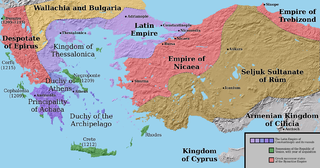
Year 1205 (MCCV) was a common year starting on Saturday of the Julian calendar.

Year 1203 (MCCIII) was a common year starting on Wednesday of the Julian calendar. It was also the first year to have all digits different from each other since 1098.
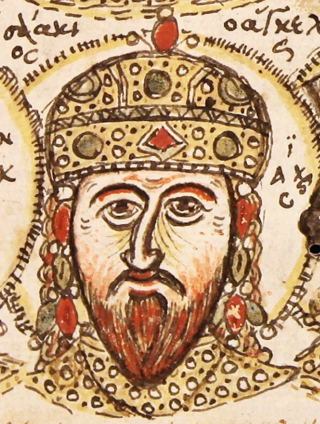
Isaac II Angelos or Angelus was Byzantine Emperor from 1185 to 1195, and co-Emperor with his son Alexios IV Angelos from 1203 to 1204. In a 1185 revolt against the Emperor Andronikos Komnenos, Isaac seized power and rose to the Byzantine throne, establishing the Angelos family as the new imperial dynasty.

Nikephoros II Phokas, Latinized Nicephorus II Phocas, was Byzantine emperor from 963 to 969. His career, not uniformly successful in matters of statecraft or of war, nonetheless greatly contributed to the resurgence of the Byzantine Empire during the 10th century. In the east, Nikephoros completed the conquest of Cilicia and retook the islands of Crete and Cyprus, opening the path for subsequent Byzantine incursions reaching as far as Upper Mesopotamia and the Levant; these campaigns earned him the sobriquet "pale death of the Saracens".

Michael V Kalaphates was Byzantine emperor for four months in 1041–1042. He was the nephew and successor of Michael IV and the adoptive son of Michael IV's wife Empress Zoe. He was popularly called "the Caulker" (Kalaphates) in accordance with his father's original occupation.
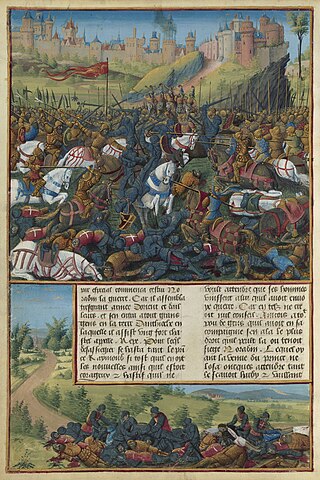
The Second Crusade (1147–1150) was the second major crusade launched from Europe. The Second Crusade was started in response to the fall of the County of Edessa in 1144 to the forces of Zengi. The county had been founded during the First Crusade (1096–1099) by the future King Baldwin I of Jerusalem in 1098. While it was the first Crusader state to be founded, it was also the first to fall.

Baldwin II, also known as Baldwin of Courtenay, was the last Latin Emperor ruling from Constantinople. He was the only Latin Emperor born in Constantinople.

The Battle of Manzikert or Malazgirt was fought between the Byzantine Empire and the Seljuk Empire on 26 August 1071 near Manzikert, Iberia. The decisive defeat of the Byzantine army and the capture of the emperor Romanos IV Diogenes played an important role in undermining Byzantine authority in Anatolia and Armenia, and allowed for the gradual Turkification of Anatolia. Many Turks, travelling westward during the 11th century, saw the victory at Manzikert as an entrance to Asia Minor.
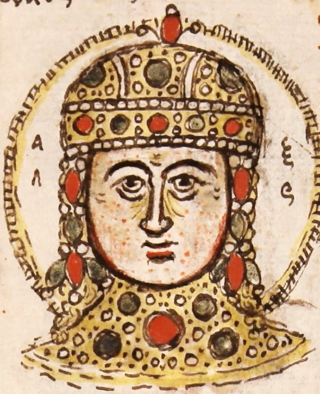
Alexios IV Angelos, Latinized as Alexius IV Angelus, was Byzantine Emperor from August 1203 to January 1204. He was the son of Emperor Isaac II Angelos and his first wife, an unknown Palaiologina, who became a nun with the name Irene. His paternal uncle was his predecessor Emperor Alexios III Angelos. He is widely regarded as one of the worst Byzantine emperors for calling upon the Fourth Crusade to help him gain power, which ultimately led to the sack of Constantinople.
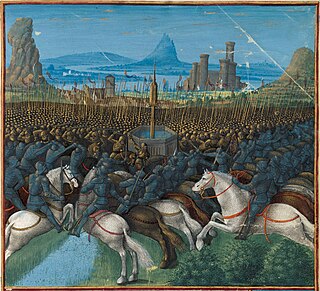
The Battle of Cresson was a small battle between Frankish and Ayyubid forces on 1 May 1187 at the "Spring of the Cresson." While the exact location of the spring is unknown, it is located in the environs of Nazareth. The conflict was a prelude to the decisive defeat of the Kingdom of Jerusalem at the Battle of Hattin two months later.
Robert Crispin, called Frankopoulos, was a Norman mercenary who fought in the Reconquista and the Byzantine Empire.

David C. Nicolle is a British historian specialising in the military history of the Middle Ages, with a particular interest in the Middle East.
The siege of Iconium was an unsuccessful attempt by the Turkish Seljuk Empire to capture the Byzantine city of Iconium, modern day Konya. After the Seljuk sacking of Ani and Caesarea in 1063 and 1067, respectively, the Byzantine army in the East found itself in too poor a shape to resist the advance of the Turks. Had it not been for the efforts of the emperor Romanos IV Diogenes the Byzantine Empire could have suffered a disaster on the scale of Manzikert sooner. From Syria, a successful counter-attack drove the Turks back. After the attack on Iconium was repelled, Romanos IV launched his second campaign. Further campaigning was met with some success by Romanos, despite the ill nature of his army, which had been poorly led since the death of Basil II in 1025.

Kafr Lam was a Palestinian Arab village located 26 kilometres (16 mi) south of Haifa on the Mediterranean coast. The name of the village was shared with that of an Islamic fort constructed there early in the period of Arab Caliphate rule in Palestine. To the Crusaders, both the fort and the village, which they controlled for some time in the 13th century, were known as Cafarlet.
Nikephoros Diogenes, Latinized as Nicephorus Diogenes, was presumably a junior Byzantine emperor around 1069–1071. He was born c. 1069 to Emperor Romanos IV Diogenes and Empress Eudokia Makrembolitissa. He was elevated to junior emperor in 1070, although he lost this position when his father was overthrown in 1071. Emperor Alexios I Komnenos, after overthrowing Nikephoros III, made Nikephoros doux of Crete, and made him a general. Nikephoros conspired against him in 1094, involving numerous confidants and relatives of Alexios, including Alexios' brother, Adrianos. For this conspiracy, he was blinded, in accordance with Byzantine traditions. After this, he retired to his estates, and spent the last years of his life studying classical literature.

Adramyttium was an ancient city and bishopric in Aeolis, in modern-day Turkey. It was originally located at the head of the Gulf of Adramyttium, at Ören in the Plain of Thebe, 4 kilometres west of the modern town of Burhaniye, but later moved 13 kilometres northeast to its current location and became known as Edremit.
Jonathan Harris is professor of the History of Byzantium at Royal Holloway, University of London. Harris's research is in the area of "Byzantine History 900–1460; relations between Byzantium and the west, especially during the Crusades and the Italian Renaissance; the Greek diaspora after 1453". His first novel, Theosis, was published in 2023.
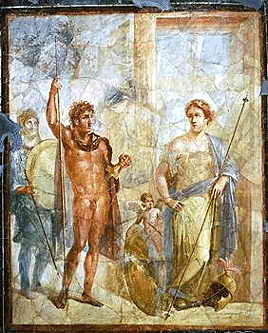
This article's aim is to gather examples of transcontinentalroyal intermarriages, that is, royal intermarriage between royal families originating from different continents. One of the best-known instances of transcontinental royal intermarriage is the one between Alexander the Great, king of Macedon, and his three Persian wives, Roxana, Stateira and Parysatis.
This list of works on the history of the Crusades and their mainly Muslim opponents, provides a select bibliography of modern works that are frequently cited in books, papers and articles that discuss these "holy wars". Thousands of histories on these topics have been published between the 11th and 21st centuries; this page only lists modern works on the topic. Works included are referenced in the notes or bibliographies of scholarly secondary sources or journals. Included works are: published by an independent academic or notable non-governmental publisher; authored by an independent and notable subject matter expert; or have significant independent scholarly journal reviews.
References
- ↑ Nicolle 2013, p. 16.
- ↑ Harris 2014, p. 39.
- ↑ Lock 2006, p. 15.